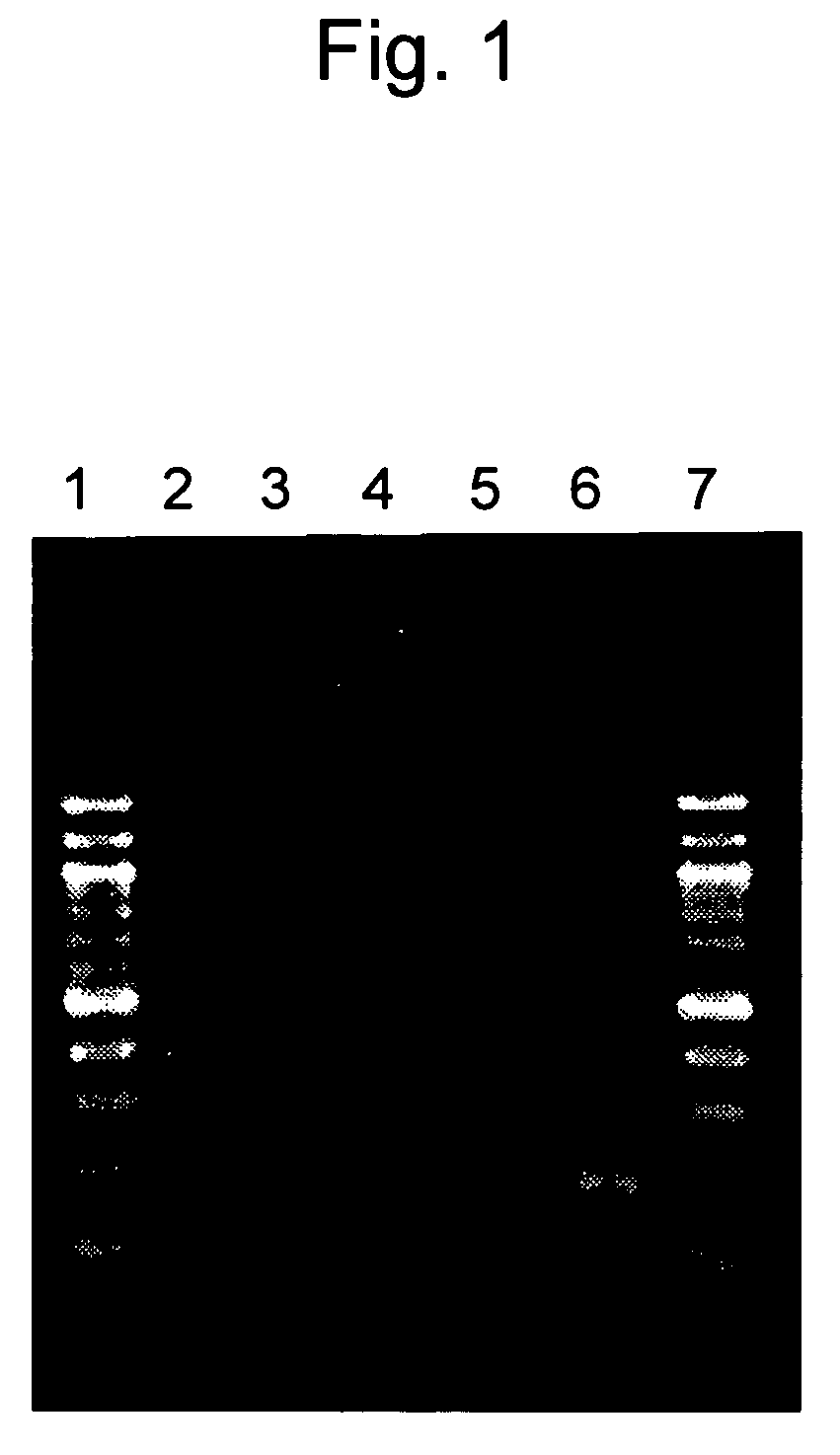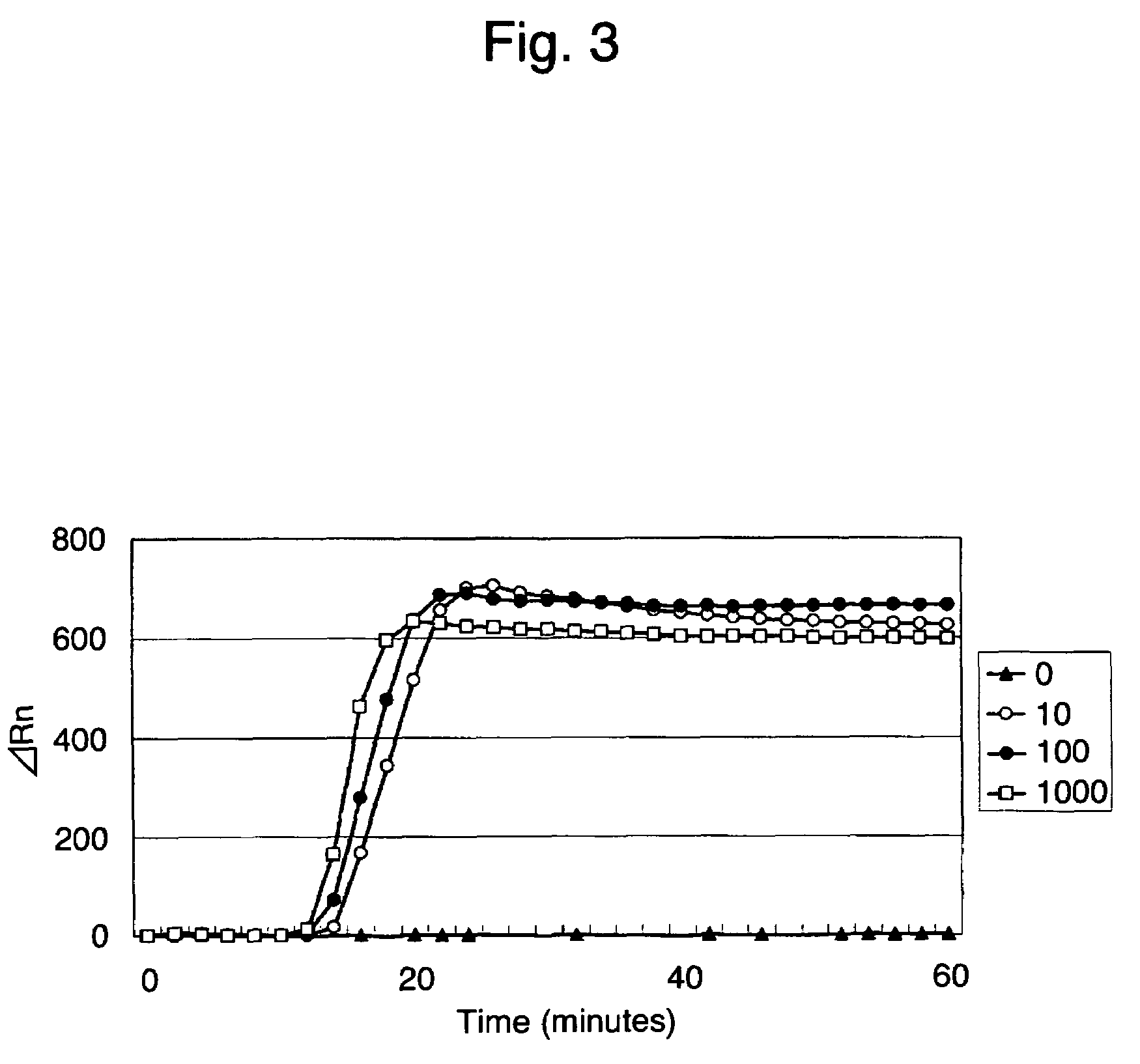Method for detecting SARS coronavirus
a coronavirus and severe acute respiratory syndrome technology, applied in the field of detecting sars coronavirus, can solve the problems of difficult to distinguish sars from other diseases based solely on symptoms, antibody cannot be detected at the early stage of the disease, and the difficulty of breathing, etc., to achieve high sensitivity and specificity, increase the number of origins of nucleic acid synthesis, and high sensitivity
- Summary
- Abstract
- Description
- Claims
- Application Information
AI Technical Summary
Benefits of technology
Problems solved by technology
Method used
Image
Examples
example 1
Confirmation of Detection Sensitivity
[0044]Sensitivity of LAMP detection was compared with that of PCR detection.
1. Preparation of Samples and Reagents
1) Samples
[0045]RNA as shown in SEQ ID NO: 1 selected from RNA polymerase sequences of the SARS coronavirus was dissolved in a yeast RNA solution (50 ng / μl, Ambion), a dilution containing 10 to 104 copies of RNA per μl and dilutions containing 2.5, 5, and 10 copies thereof were prepared, and these dilutions were designated as sample solutions. The aforementioned yeast RNA solution was designated as a sample solution containing 0 copies.
2) Composition and Concentration of Reagent Used for PCR
[0046]PCR was carried out in accordance with the method described in the non-patent document 4, wherein two types of primers each independently consisting of the nucleotide sequences as shown in SEQ ID NOs: 24 and 25 that amplify a 195-bp fragment of RNA polymerase were used as primers for detecting the SARS coronavirus.
Composition of cDNA Synthesi...
example 2
Determination of Time Required for Real-time LAMP Detection
[0080]The time required for LAMP detection with the use of the primer set A was examined using 25 μl of the composition for the LAMP method in Example 1, using a real-time fluorescent measuring apparatus (PRISM 7700, Applied Biosystems), and fixing the reaction temperature at 63° C. The results are shown in FIG. 3.
[0081]As a result, no increase in fluorescence was observed in a sample containing 0 copies 60 minutes later. In contrast, an increase in fluorescence was observed in a sample containing 10 copies or more within 20 minutes. This indicates that 10 copies were detected within 20 minutes.
[0082]The time required for LAMP detection with the use of the primer set R was examined via real-time turbidimetry using a real-time turbidity measuring apparatus (LA-200, Teramecs Co., Ltd.). The LAMP reaction was carried out using the LAMP composition (25 μl) prepared in Example 1 and fixing the reaction temperature at 63° C. The r...
PUM
| Property | Measurement | Unit |
|---|---|---|
| temperatures | aaaaa | aaaaa |
| time | aaaaa | aaaaa |
| temperature | aaaaa | aaaaa |
Abstract
Description
Claims
Application Information
 Login to View More
Login to View More - Generate Ideas
- Intellectual Property
- Life Sciences
- Materials
- Tech Scout
- Unparalleled Data Quality
- Higher Quality Content
- 60% Fewer Hallucinations
Browse by: Latest US Patents, China's latest patents, Technical Efficacy Thesaurus, Application Domain, Technology Topic, Popular Technical Reports.
© 2025 PatSnap. All rights reserved.Legal|Privacy policy|Modern Slavery Act Transparency Statement|Sitemap|About US| Contact US: help@patsnap.com



